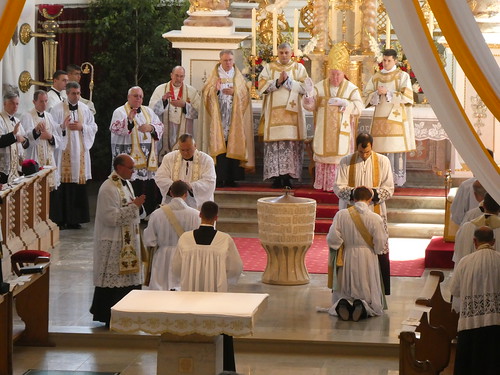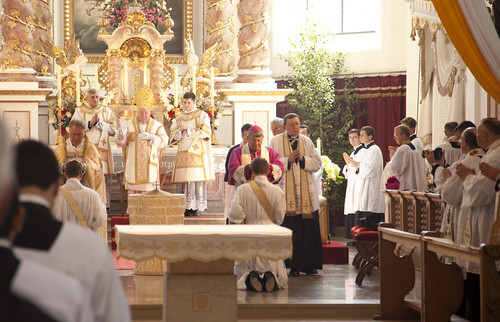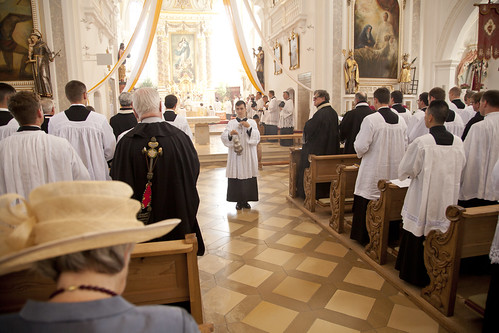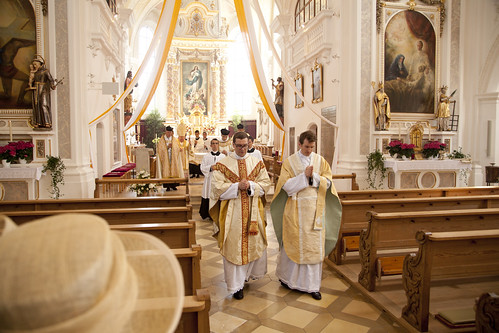Chairman's Blog
FSSP Ordinations in Bavaria: photos
 |
| Photo by Monika Rheinschmitt |
Latin and NT Greek intensive week with the LMS
 |
| Mass at Park Place at the Sewing Retreat |
Booking is open for our intensive study week of either liturgical Latin or New Testament Greek, 8th August - Saturday 13th August 2022.
The venue is Park Place Pastoral Centre, a Catholic retreat centre in Hampshire (Wickham, Fareham, Hampshire PO17 5HA).
- Find your own level with our experienced Latin tutors: Fr John Hunwicke and Ethan Freeman will be dividing students into beginners and the more advanced.
- Matthew Spencer will be teaching the New Testament Greek, as he has been doing online.
- A relaxed and Catholic atmosphere focusing on the liturgical and scriptural uses of the languages.
- A comfortable setting, with en suite single and twin rooms, and rather good food -- which we've experienced before in the Guild of St Clare Sewing Retreat.
- There are huge discounts for clergy and seminarians for the Latin.
The Teaching of the Church on Fashion: review
Christian Fashion in the Teaching of the Church, by Virginia Coda Nunziante (Calx Mariae
Publishing, 2022) pp108.
This book is being launched in London, in the St Wilfrid Hall of the London Oratory, on Thursday 9th June, and I have been asked by the publishers, Calx Mariae Publications, to review it in advance of this event. please click here for more details.
This short book comprises the author’s own introduction to the subject, and materials drawn from the speeches and writing of Popes Benedict XV, Pius XI, and Pius XII, with two final contributions from Cardinals Siri and Colombo. The documents date from 1914 to 1971. They end at this point because the Popes after Pius XII do not seem to have addressed the issue. Although small, therefore, this collection is comprehensive, at least in terms of the modern era, and for this reason extremely helpful to anyone interested in the subject.
The enormous scope of the subject make the task of the Introduction difficult, and this difficulty is compounded by the reluctance of the Popes to specify exactly what they are talking about among the fashions of their own times. The earlier part of the period covered by these documents saw the development of recreational bathing, female sports and engagement in the work-place (particularly during the world wars), as well as many style trends. There are some references to the changing role of women and new realities such as dressing for the beach, but none at all to things like the length of skirts, sleeves, swimwear, or women wearing trousers, although Cardinal Siri does attend to this last issue.
It is very difficult to say anything about the history of fashion in a short space without fear of contradiction. For example, the Introduction contrasts a period of ‘customary’ clothing before the advent of modern ‘fashion’, and there was certainly a change of tempo in the world of clothes with the advent of mass production and modern communications, but it is important to keep even this in perspective. 19th century Parisian fashions were transported across Europe and America for sale and imitation year by year, and even the clothes of the poorer majority are strikingly different century by century. On the other hand, the classic English suit, which is now found on formal occasions in every corner of the globe, has changed remarkably little since its development about 170 years ago.
Similarly, generalisations about how covered-up women were in former times need to be hedged about with qualifications. The depiction of ‘Summer’ in the Très Riches Heures du Duc de Berry, a richly decorated manuscript from early 15thcentury France, juxtaposes elegantly-dressed nobles hawking on horseback with other people bathing in a river, stark naked. Again, there is a sharp contrast between day-wear and evening-wear in 19th century clothes: Victorian evening gowns were much more revealing than what the same people would have worn in the working day, and these were themselves a reaction against the still-less modest fashions of the previous era.
There has never been a time when there was not a lively debate about clothing: as Pope Pius XII remarks, in this volume, with the Preacher, there is nothing new under the sun (Eccles. 1:9). The focus of this debate has changed, however, and has done so in confusing ways. It is useful to keep in mind three Latin terms: luxuria, modestia, and pudor. Luxuria means lust, but in modern English of course ‘luxury’ means something quite different, referring to high-status or extravagant items or lifestyle. The meaning of modestia has travelled in the opposite direction: in Latin it refers to the virtue which avoids extravagance, notably in clothing, but now, when applied to clothes, it is allied to chastity. Pudicia is commonly translated ‘modesty’, which is fair enough but can add to the confusion. It refers to a sense of shame, which is connected with social norms.
In the history of the debate over the centuries there has been a marked shift of emphasis from modesty in the old sense to modesty in the new sense. A great deal is said by the Doctors of the Church about avoiding excessive display, which is a sign of pride; the competition to wear the finest clothes could even lead to financial ruin in centuries past. Excessive extravagance still gets a mention by the modern Popes in this collection, but it is clearly much less of a problem, by their time, than clothing that is destructive of purity. I would say that, since the era of these documents, a striking new issue has arisen: of clothing associated with a nihilistic ideology of ugliness: ripped and dirty clothes, and clothes deliberately at odds with their original use, or with each other.
Fashion is a subject which requires historical perspective and careful distinctions. The most valuable contribution to the teaching of the Church in this collection is accordingly the longest and most nuanced, the address of Pius XII to an association of people involved in fashion in 1957. He makes a number of very valuable points.
First, the Church does not deprecate fashion in itself. ‘This penchant for the adornment of one’s person clearly derives from nature, and is therefore legitimate.’ Like other forms of art, fashion develops by its own authentic principles: ‘it is quite true that fashion is like art, science, politics, and other so-called profane activities, which follow their own rules to attain the immediate ends for which they are intended.’ Fashion makes an important contribution to social development: ‘It might be said that society speaks through the clothing it wears.’
On the other hand, Pope Pius XII condemns a form of what Martin Mosebach calls ‘the heresy of formlessness’:
the insistent attempts of many contemporaries to separate the exterior activities of man from the moral realm as if the two belonged to different universes, as if man himself were neither the subject nor the object of the moral realm, nor therefore responsible before the Sovereign Regulator of all things.
It is precisely because clothes are important, and have a contribution to make to the cultural development of a nation, that we cannot be passive participants in its trends. Bad trends should be resisted. Just because a particular kind of immodest garment has become widely accepted, that does not make it permissible. The promotion of such garments may even, on occasion, be the result of a malicious intention among some designers.
What, however, does this mean in practice?
We do not intend to suggest that the expansive force or the creative genius of designers should be repressed, nor that fashion should be reduced to unchanging forms, to monotony or to dismal severity. On the contrary, We mean to indicate the right road that styles should follow, so that they may achieve their end as faithful interpreters of civilised and Christian traditions.
Avoiding the errors of ignoring the problem, of accepting fashions blindly, and of a lack of moderation, Pope Pius XII appeals to the instincts of the individual: ‘the sense of shame, almost without being consulted on the matter, gives immediate warning as to where immodesty and seduction, idolatry of matter and luxury (or simple frivolity) might be lurking.’
He also appeals to the designers themselves: who of course were present in his original audience.
 |
| Raphael's La Donna Velata |
Far from wanting a return to outdated forms (which not uncommonly reappear as novelties in fashion) but wanting rather to confirm the perennial value of sobriety, We should like to invite today’s artists to dwell for a moment on certain feminine figures in the masterpieces of classical art which have undisputed aesthetic value, and where dress, marked7by Christian decency, is the worthy ornament of the person with whose beauty it blends as in a single triumph of admirable dignity.
These are beautiful words and admirable aspirations, but I know that some readers will be frustrated by the lack of specificity. They will ask, What does ‘sobriety’, ‘dignity’ and so on mean in practice? Can I wear my ripped jeans to the shops? Can I even go to the beach, let alone dress as is expected there?
The reason for this vagueness is that by definition fashion is variable, and applies to varied circumstances. What is appropriate for a car-repair workshop is not necessarily appropriate for going to church. Geography, cultural heritage, age, sex, class, all affect what is appropriate or indeed possible. What Pope Pius says is unfortunately correct: we must develop our ability to discriminate between what is practical, becoming, and appropriate, and what is not. Some of the Popes, and Cardinal Siri, called for an education of society through the efforts of organised Catholic groups, but we can’t wait for this to happen. To get through the current crisis, we will all have to think for ourselves.
I do not think this is as unhelpful as it may sound, because a large part of the problem is precisely people not thinking. Thoughtlessness is the major barrier to a healthier relationship with our clothes. Stop just wearing the easiest thing, or the thing others are wearing. Within your means, think about what will make you look nice: something becoming and dignified. For many people this thinking may be immature at first, but it would be a big step in the right direction.
And what did Cardinal Siri say about women in trousers, you ask? To find out that, I suggest you buy the book.
LMS Pilgrimage to Harvington
Pentecost: for Catholic Answers
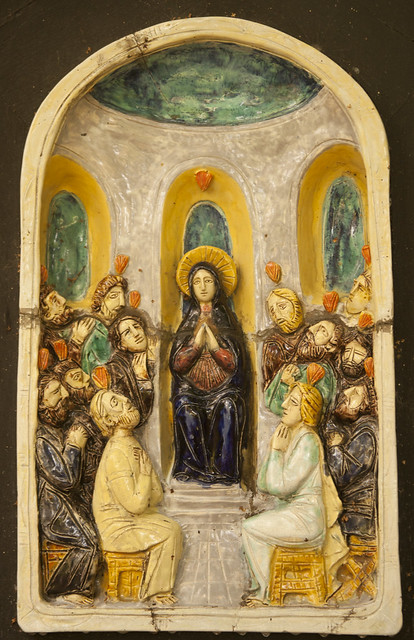 |
| The Descent of the Holy Ghost on the Apostles: from the Rosary Walk at the Shrine at Aylesford, the destination of a traditional walking pilgrimage this weekend. |
Pentecost comes from the Greek pentekoste, which means “fiftieth.” The ancient Jewish feast of Pentecost (as it is occasionally called in the Greek Old Testament) is also called the Feast of Weeks or of First Fruits, in Hebrew, Shavuot. In the year of Jesus’ passion, this was also 50 days after the Resurrection (more or less) and was the occasion of the coming of the Holy Spirit on the apostles. The Ascension had taken place forty days after the Resurrection, and Pentecost followed a nine-day period of prayer and interior preparation for this event by the apostles, in the Upper Room, the Cenacle, in Jerusalem.
Holy Scripture and the Church’s liturgical calendar alike rejoice in numerology, the symbolism of numbers. Forty is a period of preparation: the Hebrews were forty years in the desert before they came to the Promised Land; Jesus, like Moses and Elijah before key moments of their missions, spent forty days in the desert in preparation for his public ministry; we have forty days of Lent. Fifty is associated with completion and eternity: the fifty days of Eastertide represent, in a sense, the end of the story, the “happily ever after,” as well as the period between Easter and Pentecost.
Review: Unwanted Priest, by Fr Bryan Houghton
Fr Bryan Houghton: Unwanted Priest: The Autobiography of a Latin Mass Exile
Another Traditionalist Classic from Angelico is Fr Houghton’s autobiographical Unwanted Priest. With this the publisher has secured a first, however, for although it was published in French in 1990 (as Pretre rejeté), the English version never made it into print.
This has now been put right, and Houghton’s life story is available in both languages. It is a fascinating one. The son of Protestant English parents, he had much of his education in France, and became a Catholic as a young man. He had independent financial means, and consistently used this to further the apostolates he was given as a priest. While working for Northampton Diocese, he was respected as an intellectual and also elected Dean by his brother priests. Nevertheless, he was the only priest in England and Wales to resign from his position rather than celebrate the Novus Ordo Missae, in 1969. He spent his remaining years in France, where he supported an early Latin Mass apostolate, with the tacit permission of the local bishop, in a privately owned chapel. He wrote two novels well worth reading: Mitre and Crook and Judith’s Marriage, and died in 1992.
Fr Houghton’s description and analysis of what was going on in his lifetime are sober and perceptive. He distances himself from Archbishop Lefebvre, but is merciless in his assessment of the progressive faction which led the changes to the liturgy and went on to attempt a revolution in the conception of the priesthood.
Like Tito Cassini [author of Torn Tunic], Fr Houghton was particularly sensitive to the experience of the laity, and understood the laity’s mode of engagement with the liturgy as few priests of his generation did. Unlike them, as a convert he had been an adult Catholic layman himself: seminarians of that time typically went from one enclosed Catholic institution, a school, to another, the seminary, at a very young age. The laity, Fr Houghton realised, did not participate in the Mass despite the Latin and the obscurity: rather, the sacredness evinced by the ancient Mass created a setting for them to engage in contemplative prayer.
Review: Faith of our Fathers, by Chessman

This appears in the new Mass of Ages, magazine of the Latin Mass Society.
This is available to buy from the LMS online bookshop: Faith of Our Fathers | Latin Mass Society (lms.org.uk)
Stuart Chessman: Faith of our Fathers: A Brief History of Catholic Traditionalism in the United States.
The United States is the location of a major part of what we can call the Traditional Movement, but over the decades it has not had a single, continuing organisation or institution to represent it or, for that matter, to keep records. Stuart Chessman, who bloggs at The Society of St Hugh of Cluny, has put together a number of articles about the American movement’s past and present, which will do something to prevent some important events and individuals it disappearing from public consciousness, notwithstanding the geographical bias of the book.
Chessman explains the early role of those ‘conservative’ Catholics who refused to get involved in the liturgical debate; the strengths, weaknesses, and eventual collapse of Triumph magazine; and its partial replacement by the Latin Mass Magazine. Chessman notes the eagerness of Triumph to rally round the papacy following the condemnation of artificial contraception in 1968, which led to a tension in the magazine’s position as it continued to document the institutional failures of the Church in America.
A similar rallying to the establishment cause by conservative Catholics took place in the latter years of Pope John Paul II’s reign. This was led by Opus Dei and the Legionaires of Christ, and took place despite the poor episcopal treatment of conservative institutions like Ignatius Press and EWTN. It was particularly unfortunate in blinding some conservative Catholic commentators to the grim beginnings of the clerical abuse revelations. Relations between conservative and traditionalist Catholics have, since then, been transformed for the better.
One useful feature of the book is its inclusion of some historical documents. Bishop Donohoe of Fresno threatening excommunication to traditionalists in 1976; a letter from Archbishop Weakland which had to be presented by those attending a permitted Traditional Mass in 1985; a questionnaire designed to ascertain the theological soundness of would-be Old Mass-goers from the Archdiocese of New York from the same year; and so on. It is well to be reminded of some of the sillier aspects of the persecution of Catholics who, as Pope Benedict was later to describe them, were ‘totally rooted in the faith of the Church’, and wished only to worship in continuity with their predecessors in the Faith.
Review: The Great Betrayal by Hugh Ross Williamson
This is available to buy from the LMS online bookshop.
Hugh Ross Williamson, a founding figure of the Latin Mass Society, composed two important pamphlets in the early days of the movement: The Modern Mass: A Reversion to the Reforms of Cranmer (1969) and The Great Betrayal: Some Thoughts on the Invalidity of the New Mass (1970). These have been republished by Arouca Press, with Preface by his daughter, Julia Ashendon, and a Foreword by me.
The central concern of both pamphlets is the replacement of liturgical texts with clear theological implications, notably on the sacrificial nature of the Mass, with ambiguity and silence. This happened above all in the new Eucharistic Prayers and the Offertory.
The same thing happened to clear language about the necessity of penance, the intercession of the Saints, sinfulness and punishment, and our need of God’s grace. This has been documented in Lauren Pristas’ The Collects of the Roman Missals and in Matthew Hazell’s Index Lectionum, and elsewhere.
Ross Williamson was correct in surmising ecumenism as at least part of the motive, as we know from the words of the architect of the reform, Annibale Bugnini. Again, he was right to worry about the effect this silence and ambiguity on the beliefs of ordinary Catholics. I quote Pope John Paul II in my Foreword (Ecclesia de Eucharistia (2003) 10): “At times one encounters an extremely reductive understanding of the Eucharistic mystery. Stripped of its sacrificial meaning, it is celebrated as if it were simply a fraternal banquet.” This would hardly have be possible if every Mass being celebrated included the traditional Offertory and the Roman Canon.
Hugh Ross Williamson worried that this theological ambiguity impinged on the objective intention of the rites as a whole, and could make them sacramentally invalid. To be fair to him, he proposes this as something to be investigated, not as something proven. My quick answer to this argument is that (apparently at the personal insistence of Pope Paul VI) the Roman Canon was retained, almost without change, in the reformed Missal, and this makes it impossible to say that this Missal as a whole is lacks a clear presentation of the theology of sacrifice. It must be admitted, nevertheless, that it is hardly an ideal situation that one must burrow into little-used options to find a clear expression of such an important aspect of the Church’s Eucharistic Faith.
Available to buy from the LMS online bookshop.
Mass of the Ages video trilogy: Part 2 released
Summer Mass of Ages! Get your copy now.
To have it delivered each quarter, join the LMS!
If your local church doesn't get it, you can order a copy - it is free so you only pay the postage.
You can read it online on ISSUU.
In this issue: • Joseph Shaw reviews the Raphael exhibition at the National Gallery until 31 July • Charles A. Coulombe remembers Dr Halliday Sutherland, a remarkable and wise Catholic convert • Alan Frost explains how devotion to the Rosary was revived in the late 15th century by a Dominican Friar • Joseph Shaw reviews six short but important books
Our regular columnists:
• The Chairman’s Message: On what we should all be promoting
• Family Matters: James Preece on how our love of God should not remain purely theoretical
• Art and Devotion, Caroline Farey on a late 15th century Netherlandish picture by Juan de Flandes
• Rome Report, Diane Montagna talks to Abbé Brice Meissonnier, parish priest of Santissima Trinità dei Pellegrini
• Architecture: At a time when Ukraine is very much in the news, Paul Waddington takes a look at the London cathedral of the Ukrainian Greek Catholic Church
• Mary O’Regan suggests we pray for our detractors
• Wine: Sebastian Morello on the ales of The Chiltern Brewery
• World News: Paul Waddington reports from around the Globe
We promote the walking pilgrimage from Canterbury to Ramsgate, organised by the Marian Franciscans and The St Benedict Academy in Preston, who are looking to appoint tutors for the coming academic year.




